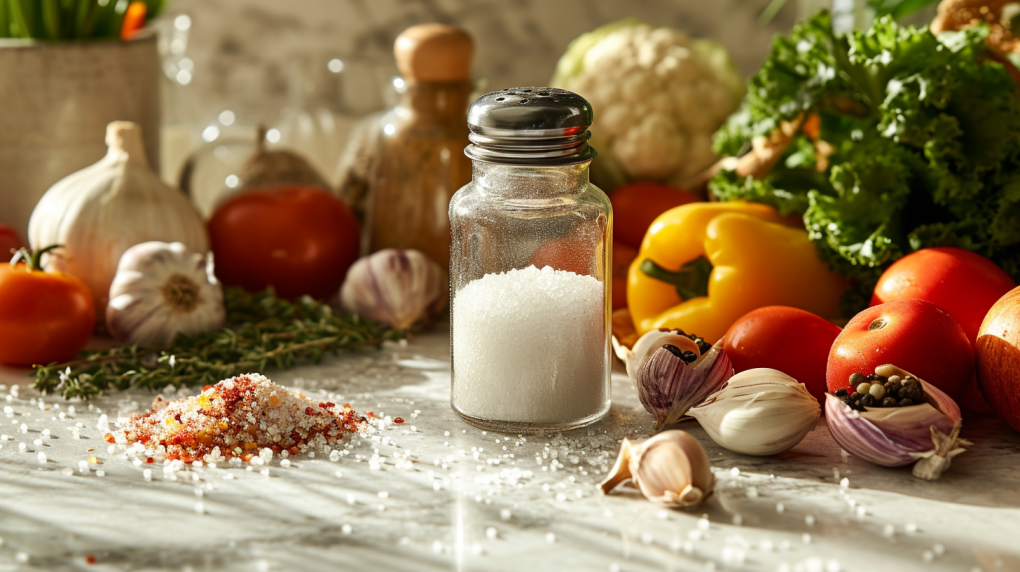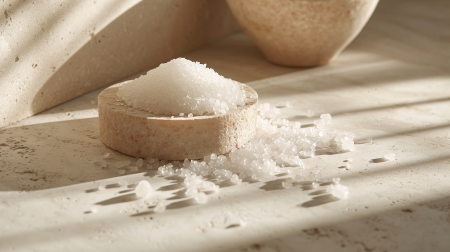
Health Effects of Salt
We find these white crystals in every home and almost every product – today we are not talking about sugar but salt, excessive consumption of which may be equally harmful to health. Do you know how much salt we can have according to official recommendations and what amounts of this popular spice are hidden in the products we consume every day? In this text we will look for answers to the above questions 🙂
Salt and Sodium
Let’s start with what salt actually is. It is important because of the correct distinction we have to make between two concepts: salt intake and sodium intake. First, salt is sodium chloride. Sodium makes up about 40% of salt. Due to the common occurrence of iodine deficiency in the past, salt in Poland is iodized (enriched with iodine). Salt is not just sodium. However, one has to admit, however, that when we talk about the impact of salt on health, we primarily mean the properties resulting from the presence of sodium.
Salt and Heart Health
I don’t know if you realize the fact that circulatory system diseases have remained the main cause of death in Poland for years. Moreover, it was estimated that 1.65 million deaths per year in the world (caused by circulatory system diseases) are related to excessive sodium consumption!
Excessive salt consumption contributes primarily to the occurrence of hypertension. Limiting salt intake to 5 g per day is one of the most important dietary modifications in the diet of people suffering from hypertension. According to the Guidelines of the Polish Society of Hypertension, this can be achieved by stopping adding salt to meals, relying on natural, fresh ingredients (vegetables, fruit) and avoiding products that are preserved with sodium compounds. This recommendation is identical to the general recommendations for healthy nutrition for the Polish population, which state that the maximum intake should amount to 5 grams per day from all food sources.

The Hard Truth
Is it difficult to implement this recommendation in practice? I think it’s best to illustrate it with an example here. One slice of wholemeal bread may contain about 0.5 grams of salt. You will find the same amount in two thin slices of yellow cheese. And one small cheeseburger from a popular fast-food chain contains even over 1.5 grams of salt! If we combine this with an all-day diet rich in various products, it is easy to conclude that not exceeding the recommended maximum value (5 grams, i.e. one teaspoon) may be a challenge.
The European Society of Cardiology states that the main source of salt in the daily diet are primarily processed products (over 70%). When comparing Poland with other European countries in terms of salt consumption, we unfortunately rank quite high, especially when it comes to men (over 14g of salt per day).
Does excessive salt consumption only contribute to hypertension? The list of possible undesirable consequences is much longer and includes: fluid retention, kidney disease, osteoporosis and increased risk of fractures, as well as stomach cancer.
I believe it is also crucial to touch upon the issues of excess weight and obesity. It has long been observed that people who eat a lot of salty products then reach for sugar-sweetened, carbonated drinks and it is a fact that salty foods increase thirst. In the long run, this situation may contribute to problems with maintaining the desired body weight. Interestingly, it is believed that sodium may also directly contribute to obesity by disturbing the metabolism of adipose tissue and thus increasing inflammation.
How to Reduce Salt Intake?
You already know what values should not be exceeded and what the health consequences of excessive salt consumption may be. You may wonder now what we can do to reduce the amount of salt in our daily diet. So, let’s get to the most important thing – action!
There are various solutions you can try:
- Use fresh, dried herbs and natural spices;
- Read labels and choose products that contain less salt;
- Make sure your diet is based on minimally processed foods (fruits and vegetables, various types of groats, legumes);
- Use salt with a lower sodium content in the kitchen (which you can buy, for example, in health food stores);
- Give up using the so-called bouillon cubes, instead you can use dried vegetables or prepare homemade cubes by freezing long-cooked broth;
- Get to know the principles of the DASH diet and use it in case of problems with the cardiovascular system, blood pressure or increased cholesterol levels (I wrote more about this diet HERE and HERE).
Time for Changes
It is difficult to change our preferences for sweet and salty foods that have been established over the years. From my observations, it is best to do it gradually to give the body time to adapt, but I also know people who have successfully gone cold turkey on their unhealthy habits. Choose the solution that is best for you. In the case of salt, we often do not realize how much we consume during the day. This is because even though we cannot see it, it is present in various products. I do hope that the strategies I have listed will be helpful and that reducing salt consumption will be your next step on the road to health 🙂
Bibliography:
- Normy żywienia dla populacji Polski i ich zastosowanie. NIZP-PZH, Warszawa 2020.
- Surma S, Romańczyk M, Bańkowski E. The role of limiting sodium intake in the diet — from theory to practice. Folia Cardiologica. 2020; 15(3):227–235. doi: 10.5603/FC.2020.0030.
- Tykarski A, Filipiak KJ, Januszewicz A, et al. Zasady postępowania w nadciśnieniu tętniczym — 2019 rok. Nadciśnienie Tętnicze w Praktyce 2019;5(1):1-86.
- Zalecenia zdrowego żywienia. NIZP-PZH; 2020.










Comments No Comments
Join the discussion…